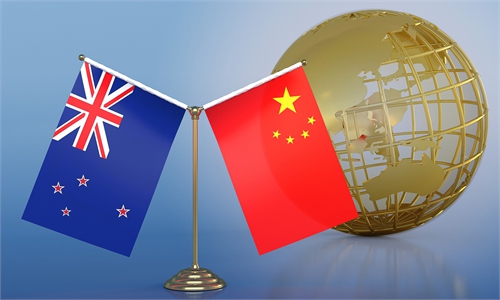
Illustration: Xia Qing/GT
New Zealand Prime Minister Christopher Luxon's visit to China demonstrates that China and New Zealand could be reliable partners in an increasingly uncertain world.
New Zealand's China policy has long been characterized by pragmatism, innovation and strategic autonomy. In 2014, the two countries elevated their relationship to a comprehensive strategic partnership. In 2017, New Zealand became the first Western developed country to sign a cooperation agreement with China on the Belt and Road Initiative. Today, China is New Zealand's largest trading partner, with two-way trade valued at more than NZ$38 billion ($23 billion) in 2024.
Political trust and economic cooperation between China and New Zealand have formed a solid foundation for the two countries to jointly address regional and global challenges. Currently, the international community faces two major issues. The first is mounting economic pressure and a backlash against globalization. With the US administration waging trade wars around the world, countries are under the shadow of protectionism. As firm defenders of free trade and multilateralism, China and New Zealand not only have highly complementary economies, but also benefit from an upgraded Free Trade Agreement (FTA) that provides institutional guarantees. Deepening trade cooperation will enable the two countries to act as constructive forces in countering protectionist trends and upholding the spirit of free trade globally.
The second major challenge is escalating geopolitical tensions and intensifying great-power rivalry. From the Russia-Ukraine conflict to India-Pakistan tensions and turmoil in the Middle East, the global order and international norms are facing serious disruption. Many countries now face increasing pressure to pick a side or become entangled in conflict. Over the past half-century, China-New Zealand relations have largely remained unaffected by such turmoil. Nevertheless, New Zealand continues to face a certain degree of external pressure. Under the framework of its "Indo-Pacific Strategy," the US has been actively wooing New Zealand to join its small circles aimed at containing China, even using technology and trade as bargaining chips. Moreover, public discourse around New Zealand potentially joining AUKUS Pillar II has been gaining momentum.
For New Zealand, it is important to see the broader picture and ensure that its choices align with the prevailing trend of history. As a military cooperation framework that includes nuclear submarine collaboration, AUKUS poses a significant threat to peace and stability in the Asia-Pacific region and risks triggering a regional arms race - something China has long and firmly opposed. On the US side, reports indicate that the Pentagon has been reviewing the AUKUS agreement, and the "America First" principle means Washington could abandon its partners at any time.
The China-New Zealand FTA has opened up a fast track for bilateral economic and trade cooperation, and both sides will continue to explore and expand new areas of collaboration. China and New Zealand began cooperating on climate change before the Paris Agreement came into effect. While many countries were still hesitant on the issue, China and New Zealand have a Climate Change Cooperation Arrangement in place. Addressing climate change requires support for industrial transformation. China's new energy vehicles and photovoltaic products can offer timely support for New Zealand's efforts to achieve its low-carbon goals and drive industrial transformation.
People-to-people exchanges will also become a new highlight of cooperation. China is New Zealand's largest source of international students and its third-largest tourism market. In 2024, China announced a unilateral visa-free policy for New Zealand citizens, while New Zealand also announced on Sunday a visa waiver policy for Chinese citizens traveling from Australia. These moves will facilitate greater exchanges in education, tourism, business and other sectors, ushering in a new chapter in cultural exchange. Furthermore, cooperation in education, research, biotechnology and the digital economy is expected to grow steadily. In today's world of rising geopolitical rivalry and pervasive uncertainty, the China-New Zealand relationship - defined by innovation, inclusiveness and rational engagement - has become all the more valuable. It provides references on how countries with different systems and sizes can engage in healthy interaction, proving that confrontation is not inevitable. As long as both sides respect each other's core interests, accommodate key concerns and build effective channels of communication, it is possible to cultivate a stable, resilient and sustainable partnership.
The author is an associate professor at the Center for Australia, New Zealand and South Pacific Studies, Chinese Academy of Social Sciences. opinion@globaltimes.com.cn



